What to do if HERO GLAMOUR PROGRAMMED FI Motorcycle engine does not start?
- SSean WiseJul 31, 2025
If your HERO Motorcycle engine won't start, a simple solution is to refill the fuel tank.
What to do if HERO GLAMOUR PROGRAMMED FI Motorcycle engine does not start?
If your HERO Motorcycle engine won't start, a simple solution is to refill the fuel tank.
Manual's purpose and scope, including motorcycle features and environmental commitment.
Location and importance of VIN and Engine Number for identification and registration.
Key specifications including physical dimensions, weight, fluid capacities, and engine performance metrics.
Technical details on the motorcycle's chassis, suspension, power transmission, and electrical components.
Essential guidelines for safe riding practices, covering proper actions and prohibited behaviors.
Advice on choosing accessories and warnings against unauthorized modifications for safety and legality.
Recommendations for maintaining a healthy motorcycle, environment, and rider through proper care and eco-friendly practices.
Labels and identification of components visible from the front of the motorcycle.
Labels and identification of components visible from the left side of the motorcycle.
Labels and identification of components visible from the right side of the motorcycle.
Description of the speedometer panel, including indicators like Hi beam and FI malfunction lamp.
Explanation of neutral indicator, speedometer, turn signal, RTMI, fuel gauge, odometer, and tripmeter.
Details on the ignition switch positions (ON, OFF, LOCK) and their respective operations.
Operation and display of the fuel gauge and RTMI, including segment indicators and mileage readings.
How to select, reset, and read the tripmeter and odometer displays.
Functions of the pass lamp, headlamp, dimmer, turn signal, and horn switches on the left handlebar.
Instructions for using the electric starter switch, including safety precautions.
Procedures for using the steering lock, seat lock mechanism, and helmet hanger for vehicle security.
How to unlock, fill, and lock the fuel tank cap, and its total capacity.
Details on recommended engine oil grade, capacity, and daily level checking procedure.
Step-by-step guide for topping up engine oil to the correct level.
Instructions on how to drain and replace the engine oil, including recommended intervals.
Recommended tyre sizes, types, and cold air pressure settings for optimal performance and safety.
How to inspect tyres for damage, wear indicators, and recommended tread depth.
A checklist of critical items to inspect daily before starting the motorcycle for safety.
Steps for starting the engine using both electric and kick starters, including neutral confirmation.
Important notes on starting, including handling flooded engines and the bank angle sensor's ignition cut-off function.
Guidance on the initial 1000 km break-in period and basic riding techniques for smooth operation.
How to apply brakes for normal stopping and emergency deceleration, with safety warnings.
Proper parking methods, including use of the main stand, and advice to prevent motorcycle theft.
How to open the utility box and a list of tools included in the kit for emergency repairs.
A list of items included in the motorcycle's first aid kit for minor emergencies.
Explanation of why regular maintenance is crucial for safe, economical, and trouble-free riding.
Essential safety precautions to follow before and during motorcycle maintenance and repair work.
Details the initial free service schedule and items to be checked or serviced at specific mileage intervals.
Continues the service schedule, detailing checks and replacements for later service intervals.
Step-by-step instructions for cleaning the engine oil filter screen and centrifugal filter.
Procedure for inspecting spark plug electrodes, checking gap, and replacing the spark plug.
Instructions on how to remove, clean, and reinstall the air cleaner element using compressed air.
How to inspect throttle cable free play and check valve clearance for smooth operation.
Specifies the correct cold valve clearance values for intake and exhaust valves.
Procedure to adjust the engine's idle speed for optimal performance.
How to check and adjust clutch lever free play for proper engagement.
Step-by-step guide to adjust clutch lever free play and verify clutch engagement.
How to inspect drive chain condition, check slack, and adjust it correctly.
Instructions on how to properly lubricate the drive chain using the recommended oil.
Steps to adjust the front drum brake lever free play for optimal performance.
How to check the brake fluid level in the master cylinder and related components.
Procedures for cleaning brake components and inspecting brake pad wear indicators.
How to adjust the rear brake pedal and check for rear brake shoe wear.
Information on battery type, location, charging, and storage recommendations.
Steps for safely removing and reinstalling the motorcycle battery.
Guide to replacing fuses and adjusting the stop lamp switch for proper brake light operation.
How to adjust the headlamp beam vertically for optimal road illumination and safety.
How to check the front forks for smooth operation and oil leakage.
How to check the rear shock absorber for smooth action and oil leakage.
Step-by-step guide to safely remove the front wheel on models with drum brakes.
Step-by-step guide to safely remove the front wheel on models with disc brakes.
Step-by-step instructions for safely removing the rear wheel from the motorcycle.
Guidelines for washing the motorcycle and protecting the catalytic converter from damage and contamination.
How the air suction valve helps meet emission standards by converting carbon monoxide.
Troubleshooting steps for when the engine fails to start, covering fuel system and electric starter issues.
Troubleshooting steps for engine stalling, poor pick-up, and related issues like air cleaner or brake binding.
Troubleshooting steps for feeble horn sound or no lights, covering fuses, battery, and bulb checks.
Explanation and examples of different types of road signs and their meanings for safe driving.
Details on the overall warranty coverage, its terms, and conditions for the vehicle.
Specific conditions and parts that are not covered under the vehicle's warranty.
Information specific to the battery warranty, including duration and terms of coverage.
Details about the warranty covering emission-related components and compliance with standards.
Advantages of using genuine spare parts and potential consequences of using non-genuine alternatives.
Contact details for Hero MotoCorp offices across different zones for service inquiries.
Manual's purpose and scope, including motorcycle features and environmental commitment.
Location and importance of VIN and Engine Number for identification and registration.
Key specifications including physical dimensions, weight, fluid capacities, and engine performance metrics.
Technical details on the motorcycle's chassis, suspension, power transmission, and electrical components.
Essential guidelines for safe riding practices, covering proper actions and prohibited behaviors.
Advice on choosing accessories and warnings against unauthorized modifications for safety and legality.
Recommendations for maintaining a healthy motorcycle, environment, and rider through proper care and eco-friendly practices.
Labels and identification of components visible from the front of the motorcycle.
Labels and identification of components visible from the left side of the motorcycle.
Labels and identification of components visible from the right side of the motorcycle.
Description of the speedometer panel, including indicators like Hi beam and FI malfunction lamp.
Explanation of neutral indicator, speedometer, turn signal, RTMI, fuel gauge, odometer, and tripmeter.
Details on the ignition switch positions (ON, OFF, LOCK) and their respective operations.
Operation and display of the fuel gauge and RTMI, including segment indicators and mileage readings.
How to select, reset, and read the tripmeter and odometer displays.
Functions of the pass lamp, headlamp, dimmer, turn signal, and horn switches on the left handlebar.
Instructions for using the electric starter switch, including safety precautions.
Procedures for using the steering lock, seat lock mechanism, and helmet hanger for vehicle security.
How to unlock, fill, and lock the fuel tank cap, and its total capacity.
Details on recommended engine oil grade, capacity, and daily level checking procedure.
Step-by-step guide for topping up engine oil to the correct level.
Instructions on how to drain and replace the engine oil, including recommended intervals.
Recommended tyre sizes, types, and cold air pressure settings for optimal performance and safety.
How to inspect tyres for damage, wear indicators, and recommended tread depth.
A checklist of critical items to inspect daily before starting the motorcycle for safety.
Steps for starting the engine using both electric and kick starters, including neutral confirmation.
Important notes on starting, including handling flooded engines and the bank angle sensor's ignition cut-off function.
Guidance on the initial 1000 km break-in period and basic riding techniques for smooth operation.
How to apply brakes for normal stopping and emergency deceleration, with safety warnings.
Proper parking methods, including use of the main stand, and advice to prevent motorcycle theft.
How to open the utility box and a list of tools included in the kit for emergency repairs.
A list of items included in the motorcycle's first aid kit for minor emergencies.
Explanation of why regular maintenance is crucial for safe, economical, and trouble-free riding.
Essential safety precautions to follow before and during motorcycle maintenance and repair work.
Details the initial free service schedule and items to be checked or serviced at specific mileage intervals.
Continues the service schedule, detailing checks and replacements for later service intervals.
Step-by-step instructions for cleaning the engine oil filter screen and centrifugal filter.
Procedure for inspecting spark plug electrodes, checking gap, and replacing the spark plug.
Instructions on how to remove, clean, and reinstall the air cleaner element using compressed air.
How to inspect throttle cable free play and check valve clearance for smooth operation.
Specifies the correct cold valve clearance values for intake and exhaust valves.
Procedure to adjust the engine's idle speed for optimal performance.
How to check and adjust clutch lever free play for proper engagement.
Step-by-step guide to adjust clutch lever free play and verify clutch engagement.
How to inspect drive chain condition, check slack, and adjust it correctly.
Instructions on how to properly lubricate the drive chain using the recommended oil.
Steps to adjust the front drum brake lever free play for optimal performance.
How to check the brake fluid level in the master cylinder and related components.
Procedures for cleaning brake components and inspecting brake pad wear indicators.
How to adjust the rear brake pedal and check for rear brake shoe wear.
Information on battery type, location, charging, and storage recommendations.
Steps for safely removing and reinstalling the motorcycle battery.
Guide to replacing fuses and adjusting the stop lamp switch for proper brake light operation.
How to adjust the headlamp beam vertically for optimal road illumination and safety.
How to check the front forks for smooth operation and oil leakage.
How to check the rear shock absorber for smooth action and oil leakage.
Step-by-step guide to safely remove the front wheel on models with drum brakes.
Step-by-step guide to safely remove the front wheel on models with disc brakes.
Step-by-step instructions for safely removing the rear wheel from the motorcycle.
Guidelines for washing the motorcycle and protecting the catalytic converter from damage and contamination.
How the air suction valve helps meet emission standards by converting carbon monoxide.
Troubleshooting steps for when the engine fails to start, covering fuel system and electric starter issues.
Troubleshooting steps for engine stalling, poor pick-up, and related issues like air cleaner or brake binding.
Troubleshooting steps for feeble horn sound or no lights, covering fuses, battery, and bulb checks.
Explanation and examples of different types of road signs and their meanings for safe driving.
Details on the overall warranty coverage, its terms, and conditions for the vehicle.
Specific conditions and parts that are not covered under the vehicle's warranty.
Information specific to the battery warranty, including duration and terms of coverage.
Details about the warranty covering emission-related components and compliance with standards.
Advantages of using genuine spare parts and potential consequences of using non-genuine alternatives.
Contact details for Hero MotoCorp offices across different zones for service inquiries.
| Displacement | 124.7 cc |
|---|---|
| Max Torque | 10.6 Nm @ 6000 rpm |
| Brakes (Front) | Disc |
| Brakes (Rear) | Drum |
| Seat Height | 790 mm |
| Weight | 122 kg |
| Wheelbase | 1273 mm |
| Engine Type | Air cooled, 4-stroke Single Cylinder, OHC |
| Fuel System | Fuel Injection |
| Fuel Tank Capacity | 10 liters |
| Starting System | Self Start |
| Tyre Type (Front) | 2.75 x 18 |
| Tyre Type (Rear) | Tubeless |
| Headlamp | 12V 35/35W Halogen Bulb |
| Max Power | 10.73 bhp @ 7500 rpm |
| Transmission | 5-speed constant mesh |
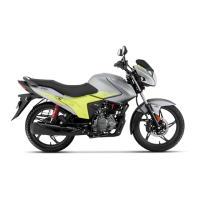
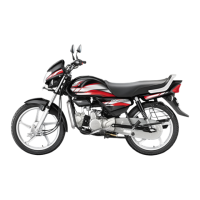

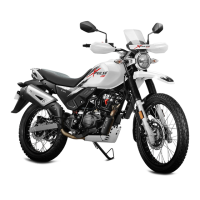

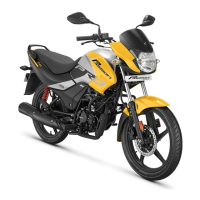
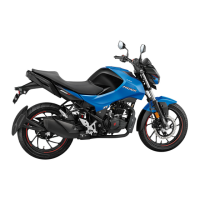
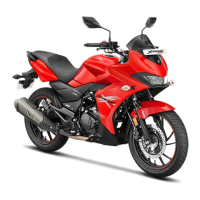
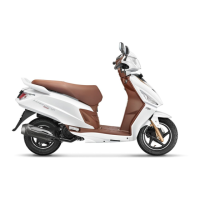
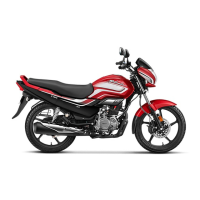
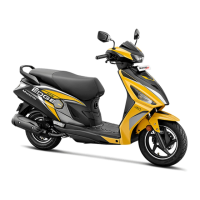
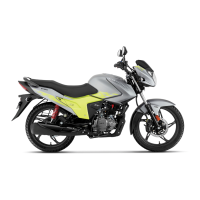
